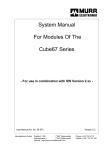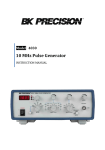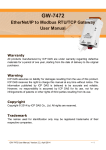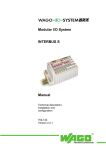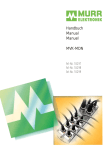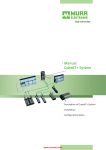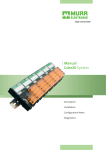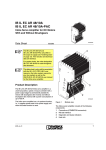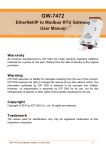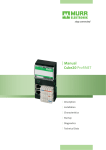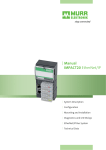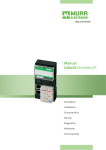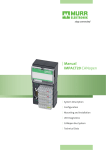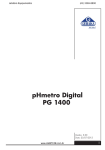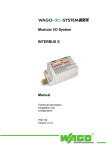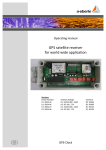Download Art.-No. 55294 Art.-No. 55295 Art.-No. 55296
Transcript
Handbuch Manual Manuel MVK-MI Art.-No. 55294 Art.-No. 55295 Art.-No. 55296 MVK-MI Series User’s Manual Art.No. 55 294 DI8 (DI8) Art.No. 55 295 DIO8 (DI8) Art.No. 55 296 DIO8(DIO8) User’s Manual Art.-No. 55 387 Murrelektronik GmbH P.O. Box 1165 71567 Oppenweiler Falkenstraße 3 71570 Oppenweiler Internet : http://www.murrelektronik.com Version 1.0 Phone++49(0)7191/47-0 Fax ++49(0)7191/47-130 MVK-MI User’s Manual 1 1.1 2 CONCERNING THIS MANUAL ................................................................................ 1 Chapter overview..............................................................................................................................1 SAFETY INFORMATION .......................................................................................... 3 2.1 Explanation of symbols ...................................................................................................................3 2.1.1 Use of attention signs..................................................................................................................3 2.1.2 Use of danger signs ....................................................................................................................3 2.1.3 Use of numbering in illustrations .................................................................................................3 2.1.4 Use of handling information ........................................................................................................3 2.1.5 Use of foot notes .........................................................................................................................3 2.2 Designated use .................................................................................................................................4 2.3 Qualified personnel ..........................................................................................................................5 3 CONFIGURATION INFORMATION .......................................................................... 6 3.1 System description ..........................................................................................................................6 3.2 System data ......................................................................................................................................8 3.3 Information for the beginner ...........................................................................................................9 3.4 Electrical specifications.................................................................................................................10 3.4.1 System cables ...........................................................................................................................10 3.4.2 Power supply.............................................................................................................................12 3.4.3 Recommended power supply units MCSPower+ ......................................................................12 3.4.4 Conductor cross-sections..........................................................................................................12 3.5 Slave profile ....................................................................................................................................13 3.5.1 Identification code .....................................................................................................................13 3.6 System configuration.....................................................................................................................14 3.6.1 Physical addressing ..................................................................................................................14 3.6.2 Logical addressing ....................................................................................................................15 4 4.1 INSTALLATION INFORMATION............................................................................ 16 Connection overview .....................................................................................................................16 4.2 Connection to MVK-MI ...................................................................................................................17 4.2.1 Grounding cable ........................................................................................................................17 4.2.2 Interbus connection ...................................................................................................................18 4.2.3 Pin assignment: M12 (B-coded) bus connector ........................................................................18 4.2.4 Pin assignment: 7/8" power connector (Mini-Style) ..................................................................18 4.2.5 Power supply connection ..........................................................................................................19 4.2.6 Connection of digital sensors and encoder ...............................................................................20 4.3 Installation.......................................................................................................................................24 4.4 Installation clearance .....................................................................................................................25 MVK-MI User’s Manual Electromagnetic compatibility (EEC)........................................................................................... 26 4.5 4.5.1 Protection against electrostatic discharge ................................................................................ 26 4.5.2 Grounding ................................................................................................................................. 27 4.5.3 Cable routing ............................................................................................................................ 27 4.5.4 Voltage drops............................................................................................................................ 27 4.5.5 Inductive load interference suppression ................................................................................... 28 4.5.6 Limits and what can still be done.............................................................................................. 28 5 5.1 6 DIAGNOSIS DISPLAYS ......................................................................................... 29 Bus / Device status displays......................................................................................................... 29 INTERBUS WORD STRUCTURE .......................................................................... 30 6.1 MVK-MI DI8(DI8) Art.Nr. 55294...................................................................................................... 30 6.2 MVK-MI DIO8(DIO8) Art.Nr. 55295 ................................................................................................ 31 6.3 MVK-MI DIO8(DIO8) Art.Nr. 55296 ................................................................................................ 32 7 PARAMETERIZATION ........................................................................................... 33 7.1 Parameterization of Pin 2 as an input or diagnosis input ......................................................... 33 7.2 Implicit parameterization as a digital input or digital output .................................................... 33 8 TECHNICAL DATA ................................................................................................ 35 8.1 Mechanical data ............................................................................................................................. 35 8.1.1 DI8(DI8) Art.Nr. 55 294, DIO8(DI8) Art.Nr. 55 295, DIO8(DIO8) Art.Nr. 55 296...................... 35 8.2 9 10 Electrical data................................................................................................................................. 36 ACCESSORIES ...................................................................................................... 37 DESCRIPTION OF TERMS ................................................................................. 38 MVK-MI User’s Manual Manual supplements / Corrections Version V 1.0 Notes: Chapter Supplements / Corrections Created Date/ Name 11.04.05 M.H./ HE MVK-MI User’s Manual 1 Concerning this manual Please take the time to read this User’s Manual prior to setting up and operating MVK-MI components. The User’s Manual must be kept in a conspicuous place and accessible to all authorized personnel. The text, illustrations, diagrams and examples used in this manual serve solely for the purpose of explanation, operation and application of Input/Output modules of the MVK-MI series. If you should have any further reaching questions regarding the installation and set-up of the equipment described in this manual, please don’t hesitate to contact us. We would be glad to assist you any time. Murrelektronik GmbH P.O. Box 1165 Falkenstraße 3 71567 Oppenweiler 71570 Oppenweiler Phone: Fax: ++49(0) 7191/47-0 ++49(0) 7191/47-130 Internet : http://www.murrelektronik.com Murrelektronik reserves the right to make technical changes or modifications to this manual without prior notice. 1.1 Chapter overview The “Safety information” section must be read without fail prior to working with the products and the system. This section contains information required for safe installation and handling. The “Configuration Information“ section directs itself to system planners. It offers important information and details relevant to successful configuration. The “Installation” section provides details regarding installation, in both mechanical and electrical contexts. This chapter addresses itself in particular to qualified and trained electricians responsible for the assembly and installation of system components. The “Setup“ and “Diagnosis“ sections are intended for the setup personnel. They offer important notes and information with regard to the rapid and uncomplicated setup in a Profibus DP network. V 1.0 1 MVK-MI User’s Manual 2 Safety information 2.1 Explanation of symbols 2.1.1 Use of attention signs Notes containing important information are specially marked. These are illustrated as follows: Attention text........... 2.1.2 Use of danger signs Danger signs are additionally marked with an enclosing frame. Caution: Disregard of safety measures may result in damage to equipment and other serious consequences. DANGER: Non-compliance with the relevant safety measures poses a danger to the health and life of the user. 2.1.3 Use of numbering in illustrations Illustrations are numbered with white numbers in black, round fields. Example: Text 1...... Text 2...... Text 3...... The explanatory text follows in tabular form under the same number, in direct context to the preceding illustration. 2.1.4 Use of handling information Handling information describes the sequence of steps during installation, setup, operation and maintenance that must be strictly observed. The numbering (black numerals in a white field) is given in a sequential and ascending order. Example: Instruction 1........ Instruction 2........ Instruction 3........ 2.1.5 Use of foot notes Supplementary information is marked with superscripted numerals (example: Text Text These are explained in the form of footnotes beneath tables or text at the end of the page. V 1.0 1) Text Text). 3 MVK-MI User’s Manual 2.2 Designated use The devices described in this manual serve as decentralized input/output modules intended for connection to a Intebus network. The products described in this manual • have been developed, manufactured, tested and documented in compliance with currently valid safety codes. The equipment poses no danger to operating personnel or material if configuration, assembly, and operation are performed in compliance with the stated handling and safety regulations. • fulfill the requirements of: • • • EMC directives (89/336/EWG, 93/68/EWG and 93/44/EWG) low voltage directive (73/23/EWG) and are designed for use in an industrial environment. An industrial environment is one where the consumers are not directly connected to the public low voltage supply network. Additional measures must be taken for use in residential areas or in office and business environments. Warning! This is class A rated equipment. Operation of this equipment in a residential environment can cause radio interference, in which case the user can be required to take necessary corrective measures. Fault-free and safe function of this equipment is guaranteed only if the conditions for proper transport, storage, installation and assembly are observed. The designated operation of the device is guaranteed only with the housing fully installed Good chemical and oil resistance. When using aggressive mediums, material resistance based on application must be checked. All devices connected to this equipment must fulfill EN 61558-2-4 and EN 61558-2-6 requirements. Only qualified and suitably trained electrical tradesmen knowledgeable in the safety standards of automation technology may perform configuration, installation, setup, maintenance and testing of the equipment. Current safety and accident prevention laws valid for a specific application must be observed in the configuration, installation, setup, maintenance and testing of the equipment. Only cables and accessories are allowed that meet the requirements and regulations for safety, electromagnetic compatibility and, where applicable, telecommunications transmission equipment and specifications. Information concerning the type of authorized cables and accessories can be obtained from your Murrelektronik distributor or are described in this manual. 4 V 1.0 MVK-MI User’s Manual 2.3 Qualified personnel Requirements to be met by qualified personnel are based on qualifications profiles described in ZVEI and VDMA guidelines. Weiterbildung in der Automatisierungstechnik (Further training in automation technology) Herausgeber: ZVEI and VDMA (Publisher: ZVEI and VDMA) Maschinenbau Verlag P.O. Box 71 08 64 60498 Frankfurt Only trained electricians familiar with the contents of this manual may be allowed to install and service the components described here. These are understood as being persons who, • • based on their trade qualification, experience and knowledge of relevant standards, are able to assess the project requirements and to recognize possible hazards. based on extensive experience in comparable areas, possess the same level of knowledge as could be expected of a trained tradesman. Only Murrelektronik technical personnel are allowed to undertake intervention in the hardware and software of our products, unless the procedure is described in this manual. Warning! Unqualified intervention in the hardware and software of our equipment or the disregard of warnings and information provided in this manual can result in injury or serious damage to man and/or material. V 1.0 5 MVK-MI User’s Manual 3 Configuration information 3.1 System description The Interbus is a high-speed, universal sensor/actuator bus system n the form of a data ring. A serial bus cable connects the master to input/output modules installed in the system. The necessary wiring can therefore be reduced to a minimum in comparison to conventional parallel wiring. Each slave constitutes part of a shift register which, when combined, forms a large shift register. Data transfer takes place in a master-slave-access process. The ring structure offers the possibility of simultaneous transmission and reception of data (full duplex). The bus cable between individual participating modules always contains conductors for forward and for return transmission of data signals. Master ♦ Slave Slave Slave Slave Fig. 3-1 Bus topology/Data ring The application area concentrates mainly on lower level industrial automation for networking of analog and binary sensors and actuators. The Interbus is a substitute for traditional wiring between sensors, actuators and the PLC. System-based mechanisms and software tools effectively support setup, operation, maintenance and diagnosis. Every Interbus system requires a control unit, the master. This is available as a PLC specific module or in the form of a PC card. The application program on the control system or PC controls the process via the master and the decentralized I/O groups, the slaves. The master performs cyclical information exchange between the master and the slaves independently. An identification cycle is started immediately after switch-ON. During this system initialization phase, the master reads the identification data of all slaves in the sequence of their physical location. This data serves (among other things) to prepare a periphery map in the master. Subsequent cycles are purely data cycles and serve solely to exchange process data between the master and the slaves. According to standard specifications, an Interbus network supports the operation of maximum 256 slaves and can reach a max. extension of 13 Km with copper cables and >80 Km using fiber optic cables. The distance between individual remote bus modules must not exceed 400 m (using copper conductors). The following transmission distances between two modules are possible when using fiber optic cable technology: Polymer fiber max. 50 m HCS fiber max. 300 m Glass fiber max. 2500 m Besides the remote bus, there is also a remote Installation bus. The remote Installation bus differs from the remote bus as follows: The power supply (24 V DC) is carried by the system cable. The max current is limited to 4.5A according to specifications. The sum of all cable segments is maximum is 50m. 6 V 1.0 MVK-MI User’s Manual MVK-MI modules are suitable for operation in the remote bus. In te r fa c e m o d u le B u s m a s te r R e m o te 50m In s ta lla tio n r e m o te R em o te bus 1 2 .8 Km 50m 400m 400m ♦ Fig. 3-2: Interbus system topology The cycle time depends on the degree of expansion. With full system expansion, 4096 I/O points, the cycle time is: 7.2ms. V 1.0 7 MVK-MI User’s Manual 3.2 System data Topology Transmission media Active ring – Tree structure with max. 16 levels - Copper cable (RS-485; Transmission distance 400 m) - Fiber optic cable (Polymer 50 m, HCS 300 m, glass fiber 2500 m) Sum of all cable segments max. 12.8km Sum of all cable segments max. 50 m Cable length of remote bus Cable length of remote Installation bus Number of remote bus modules Max. 256 (limited by master firmware) Number of Interbus modules Max. 512 (limit due to handling) Number of I/O points Max. 4096 Number of data words Max. 256 Baud rate Messages 500 kBaud Cyclic messages from the master to individual slaves (Master call) with instant reply from slave (slave reply) 0.105 ms Data cycle time per slave (without master run time) DI16/DO16 Error recognition Master functions Identification of faulty messages, automatic repeat - System initialization - Automatic slave detection - Non-cyclical parameter transmission - Bus and slave diagnosis - Error messages to control Table 3-1: Interbus system data 8 V 1.0 MVK-MI User’s Manual 3.3 Information for the beginner The Interbus is a field bus system for industrial application whose advantages include not only ease of handling in planning and application, but also a good general overview of the total system. To make the system even easier and safer for beginners to use, we recommend proceeding as outlined in the checklist below: Work phase Planning Questions Note How many I/O’s are required in This determines which types and how many total? Interbus modules are required. Planning How great is the system power Important for the selection of suitable system requirement? power supply units and conductor cross sections. Planning How large is the total scope of The sum of all cable lengths may not exceed 12.8 the system? Km if using copper cables. Configuration How are the modules to be To avoid assignment errors, create an assignment assigned? scheme and carefully label all modules accordingly. Installation Where will installed? Setup How will the system configuration Automatic system configuration. be executed? The C (Configuration), M (Monitoring), D (Diagnostic) software is recommended for the setup. Have all slaves been detected by When all slaves have been detected, data transfer the master? is active and the “BA” and “RC” LED’s on the slaves will light up green. The “RD” LED is OFF. How can a simple I/O function Quick and straightforward, with special, easy to test be performed? use configuration software (CMD). Alternatively via PLC software. Setup Setup V 1.0 the modules be Depends on the module enclosure type rating. Either in a switch cabinet or terminal box. Place modules of enclosure type IP 67 close to sensors and actuators for the sake of greater efficiency. 9 MVK-MI User’s Manual 3.4 Electrical specifications 3.4.1 System cables On the field bus side, system cables can be either of the remote bus or remote installation bus type, depending on different application requirements. 3.4.1.1 INTERBUS remote bus cable The Interbus remote bus cable contains 3 stranded conductor pairs with a common screen. green yellow pink grey brown ♦ 10 - Remote bus cable - Screen Fig. 3-3: Remote bus cable V 1.0 MVK-MI User’s Manual 3.4.1.2 System cable specifications Characteristic value (20°C) Conductor cross-section DC conductor resistance per 100m Value Min. 0.2 mm² Max. 9.6 Ω Characteristic impedance 120 Ω ± 20 % at f = 0.064 MHz 100 Ω ± 15 Ω at f > 1 MHz Dielectric strength - Conductor / conductor - Conductor / screen Insulation resistance (following dielectric strength test) Max. Transfer impedance (transfer impedance) at 30 MHz) Operation capacity at 800 Hz Min. close-up cross-talk impedance (NEXT) for 100 m cable - at 0.772 MHz - at 1 MHz - at 2 MHz - at 4 MHz - at 8 MHz - at 10 MHz - at 16 MHz - at 20 MHz Max. wave attenuation for 100 m cable - at 0.256 MHz - at 0.772 MHz - at 1 MHz - at 4 MHz - at 10 MHz - at 16 MHz - at 20 MHz Test method VDE 0472-501 IEC 189-1 cl. 5-1 1000 Veff , 1 min. 1000 Veff , 1 min. Min. 150 MΩ for 1 km cable 250 mΩ/m Max. 60 nF for 1 km cable IEC 1156-1 cl. 3.3.3 VDE 0472-509 test type C or IEC 189-1 cl. 5.2 VDE 0472-502 test type B or IEC 189-1 cl.5.3 IEC 96-1 VDE 0472-504 Test type A or IEC 189-1 cl. 5.4 VDE 0472-517 or IEC 1156-1 cl. 3.3.4 61 dB 59 dB 55 dB 50 dB 46 dB 44 dB 41 dB 40 dB VDE 0472-515 or IEC 1156-1 cl. 3.3.2 1.5 dB 2.4 dB 2.7 dB 5.2 dB 8.4 dB 11.2 dB 11.9 dB The following mechanical requirements apply to limited flexible cable routing (occasionally moved) and permanent routing in a dry, moist environment: Variable Temperature range Color coding of data cables Color coding of power supply cables Jacket color Maximum outer diameter Minimum jacket inner diameter Minimal bending radius Connection method V 1.0 Value -20 °C to +70 °C According to DIN 47100 Red, blue, yellow/green Green RAL 6017 8 mm 5 mm 80 mm Suitable for round plug connector IP65 9-pin (Coninvers) 11 MVK-MI User’s Manual 3.4.2 Power supply Interbus modules require a power supply of typically 24V DC, which must meet normal industrial power supply requirements. We recommend the use of separate power supply sources for sensor & bus power and for the actuator power, in order to assure a higher degree of noise immunity and insulation. Primary switched-mode or unregulated power supplies should be used for voltage supply The rating of the power supply units depends on the number of connected modules and on their power rating. ATTENTION: Always ensure that the system power, measured at the device furthest away from the system power supply, does not drop below 18V DC. System behavior is undefined if the sensor & bus power supply drops below 18V. Primary switched-mode power supply units, as a rule, allow the output voltage to be raised above the rated voltage in order to compensate for loss in the lines. Interbus modules with digital inputs allow the direct connection of commercially available sensors. A separate power supply for the sensors may be necessary, depending on the total power requirements of the overall system based on the number of slaves or when using sensors with high current consumption. 3.4.3 Recommended power supply units MCSPower+ Primary switched-mode power supply devices of the MCSPower+ series are especially well suited for power supply to automation systems. We therefore recommend their use in supplying the MVK-MI. Phases Power output 1 1 240 W / 10 A 480 W / 20 A Phases Power output 3 3 3 240 W / 10 A 480 W / 20 A 960 W / 40 A 3.4.4 Power input 95...132 VAC 85086 85088 Power input 185...265 VAC 85085 85087 Power input 3 x 340...460 VAC 85095 85097 85099 Conductor cross-sections The core cross-section is limited to max. 1.5 mm² and is restricted to this size by the 7/8” connector. 12 V 1.0 MVK-MI User’s Manual 3.5 Slave profile 3.5.1 Identification code The Interbus master marks each slave with an identification code to assure unequivocal, functional identification. This code is permanently programmed by the manufacturer and cannot be changed. The conditions for this are listed in the Interbus specifications. The identification code consists of one data word (16 Bit). Bit 15 14 13 Management bits ♦ 12 11 10 9 Data width of module 8 7 6 5 4 3 2 1 Device group ID-Code or Ident. code 0 Fig. 3-4: Bit assignment of identification code Management bits 13-15 transfer dynamic error messages to the master if a fault occurs. Bits 8-12 define the data width of the slave. Data widths from 4 Bits to 32 words are possible. Example: A slave with 16 input bits and 8 output bits occupies 1 word in the input area and 1 word in the output area. The larger value is always decisive in establishing the module-specific data width. With the aid of bits 0-7, the master can identify the slave function and assign the I/O data to the various areas of the process map. Bits 0-7 are also referred to as ID codes. Modules of the MVK-MI series have the ID code 3 and a data width of 2 words V 1.0 13 MVK-MI User’s Manual 3.6 System configuration The master has identified all its slaves during the initialization phase and has received information as to their data widths. Based on this information, the master creates a periphery map of all detected slaves in the data ring. PLC Interbus slaves Interbus-Master Interface module MVK- MI DI8 (DI8) 2 Words, ID 3 Periphery map „Inputs“ Process input image (PII) Input data Module 1 Diagnosis data Module 1 Periphery map “Outputs” Output data Module 2 Parameter data Module 2 Output data Module 3 Parameter data Module 3 Process output image (PIO) Installation remote bus Output data Module 1 Parameter data Module 1 ♦ Remote bus or Input data module 3 Diagnosis data Module 3 PLC- Program • • • • Input data Module 2 Diagnosis data Module 2 Input data Diagnose Output data Parameter MVK- MI DI08 (DI8) 2 Words, ID 3 • • • • Input data Diagnose Output data Parameter MVK- MI DIO8 (DI08) 2 Words, ID 3 • • • • Input data Diagnose Output data Parameter Fig.3.6- : Data transfer between PLC, interface module (Master) and Interbus slaves The Interbus master creates a periphery map of all detected Interbus slaves and addresses them according to their physical location in the field bus. The user has the option of assigning the physical periphery map of the Interbus slaves to logical addresses in the PLC. 3.6.1 Physical addressing The assignment of the periphery map in the master to the process map of the PLC reflects the physical arrangement of the modules in the field bus. Advantage: No configuration expenditure, the assignment is automatic Disadvantage: Hardware changes in the periphery cause structural changes in the periphery map and thereby also to the process map in the control. 14 V 1.0 MVK-MI User’s Manual 3.6.2 Logical addressing Logical addressing can be performed manually during the configuration phase (depending on the master module employed), by using a suitable configuration software (e.g. CMD). The periphery map or parts of the periphery map is thereby logically assigned to the process map of the control. Advantage: Hardware changes in the periphery produce no structural changes in the control process map. No configuration expenditure, as assignment is automatic. Disadvantage: Increased configuration expenditure. V 1.0 15 MVK-MI User’s Manual 4 Installation information 4.1 Connection overview 3 7 2 6 1 5 0 4 ♦ Fig 4-1: MVK-MI module connection layout Mounting hole M12 round connectors for inputs and outputs Identification label Display elements Power supply connection Outgoing power supply connection Incoming bus interface Outgoing bus interface FE connection 16 V 1.0 MVK-MI User’s Manual 4.2 Connection to MVK-MI Connect the grounding cable to the FE terminal Connect incoming Profibus cables to the incoming bus terminal . Connect any outgoing Profibus cables to the outgoing bus terminal or attach terminating resistor to the outgoing bus terminal . 4.2.1 Grounding cable The FE connection is located at the bottom/side of the module housing. ♦ Fig. 4-2: FE connection ID. labels FE connection Connect the grounding cable at the FE connection on the housing in a low impedance manner. V 1.0 17 MVK-MI User’s Manual 4.2.2 Interbus connection 4.2.2.1 Cables Interbus field bus cable connection requires cables conforming to Interbus specifications. We recommend using our prepared Interbus cables for easy and reliable wiring of the equipment. The Interbus cables can also be prepared by yourself. We offer the following accessories: Art . No. 55 771 50 27606 50 27601 Description Comments Interbus bus cable remote bus (by the meter) M12 male connector B-coded, straight (screened) M12 female connector, B-coded, straight (screened) Art. No. 55 356 Description Terminating resistor plug Any sockets that are not in use must be fitted with blind caps as IP 67 protection is otherwise not guaranteed. Art. No. 55 468 33 8155 55 390 4.2.3 Description M12 blind caps, black (4) Diagnosis blind plugs M12 Blind cap 7/8“ (external thread) Pin assignment: M12 (B-coded) bus connector 3 5 4 2 2 1 1 BUS IN ♦ 5 3 4 BUS OUT Fig. 4-3: Bus connector pin assignment pin No. 1 2 3 4 5 Threaded Signal DO /DO DI /DI GND Screen Significance Data line of IBS master Data line of IBS master inverts Data line of IBS master Data line of IBS master inverts Ground Screen or FE Colour yellow green grey pink brown The screen should be evenly distributed around the thread. 4.2.4 18 Pin assignment: 7/8" power connector (Mini-Style) V 1.0 MVK-MI User’s Manual POWER IN POWER OUT 1 1 2 2 5 3 ♦ 4 5 4 3 Fig. 4-4: Pin assignment: pin 1 Pin 2 pin 3 Pin 4 pin 5 4.2.5 0V 0V PE Sensor & bus power supply Actuator power supply Power supply connection 4.2.5.1 5-pin Mini-Style connector (7/8") ♦ Fig. 4-5: Preparing the power supply cable ATTENTION: Reverse polarity of the power supply can cause damage to the module. V 1.0 19 MVK-MI User’s Manual 4.2.5.2 Connecting the power supply to the module Auxiliary power supply is required for actuators and sensors. The MVK-MI electronics are supplied from the sensor power supply. The sensor power supply may not be of the switchable type as this voltage supplies power to the module electronics! ATTENTION: The 7/8“ plug connector is designed for max. 9 A current per pin. This must be taken into account for downstream power supply. In order to reduce the power loss upon the incoming cable from the power supply to the MVK-MI module is recommended a 1,5mm² wire gauge. The recommended wire gauge from the MVK-MI module to the actuators is 0,75mm². 4.2.6 Connection of digital sensors and encoder 2 1 5 4 ♦ 3 Fig. 4-6: M12 socket assignment Pin 1 Pin 2 Pin 3 Pin 4 Pin 5 + 24 V Function channel 1x 0V Function channel 0x FE Sensor supply Parameterizable channel Reference potential Parameterizable channel Ground Any sockets not in use must be fitted with blind caps, as IP 67 protections is otherwise not guaranteed. 20 V 1.0 MVK-MI User’s Manual 4.2.6.1 Logical signal display and LED response Normally open input Normally closed input Diagnosis input Voltage at input 0V 24 V 0V 24 V 0V 24 V Logical value 0 1 1 0 1 0 LED display1 OFF Yellow OFF Yellow Red OFF Logical value 0 1 Voltage at output 0V 24 V LED display OFF Yellow Output 4.2.6.2 Sensor power supply Sensors can be supplied via pin 1 (+24V) and pin 3 (0V) of the M12 sockets. A re-settable PTC per M12 socket protects the sensor supply. The max. current draw for sensor power supply is 200 mA for each M12 socket. Please note the following derating diagram. Derating sensor power supply 250 200 150 I / mA 100 50 0 0 10 20 30 40 50 60 T / °C 1 If a channel-related diagnosis is active, the LED assigned to this channel will light up red. V 1.0 21 MVK-MI User’s Manual 4.2.6.3 Actuators Each output can be loaded to a maximum of 1.6 A. Maximum output current per port 3,2A (each 1,6A) <= 40°C room temperature. Maximum output current per port 2,8A (each 1,6A) <= 55°C room temperature. Attention: The sum current may not exceed 9 A due to the maximum current carrying capacity of the power connector. When routing the actuator power supply forward, please assure that the sum current of all modules does not exceed 9 A. Attention: Reverse polarity of the actuator power can damage the module! Attention: The module may heat, depending on the load! If an overload or short-circuit occurs at an output, that output will be disabled. This output will remain disabled even when the error has been corrected. In order to reset the short-circuit memory, the output must be switched off at the control. Targeting a fast short circuit shutdown time is recommended to not exceed the following cable lengths: max 15m incoming cable 1,5mm² and max 1,5m actuator cable 0,75 mm² max 10m incoming cable 1,5mm² and max 3m actuator cable 0,75 mm² 22 V 1.0 MVK-MI User’s Manual 4.2.6.4 Diagnosis input Pin 2 of the M12 socket can be parametered as a diagnosis input on all modules. If a 0 volt signal is present at a diagnosis input, it will be inversely displayed in the process map. At the same time, the Interbus diagnosis will issue a channel-specific diagnostic message. 4.2.6.4.1 Examples of using the diagnosis function at Pin 2 When Pin 2 is parametered as a diagnosis input, it always responds as an inverted input. This means that in the case of 0 V -> logic “1“ the assigned LED will light up red. This allows external device errors to be displayed at the MVK-MI. Several possible examples are presented below. 4.2.6.4.1.1 Connecting sensors and actuators with diagnosis output For this example, assume that a sensor or actuator with a diagnosis output is being used. This diagnostic signal can also be evaluated with a conventional I/O system. It can be processed and displayed in the control. However, you have no visual error display near the defective sensor which, moreover, is probably also mounted in a non-visible location. The optical display at the M12 socket of the MVK-MI facilitates exact on-site location of the error. M12 Socket 1 (+) 2 Diagnosis 3 (-) DESINA Sensor 4 (S) Detection of: ♦ Front surface damage ♦ Defective electronics ♦ Open-Load 4.2.6.4.1.2 Cable breakage monitoring With the M12 diagnostic adapter, Murrelektronik GmbH offers a simple tool for monitoring the M12 cables to the sensors or actuators for cable breakage. M12 Socket 1 (+) M12 Adapter with socket 1 (+) 2 Diagnosis V 1.0 3 (-) 3 (-) 4 (S) 4 (S) Sensor 23 MVK-MI User’s Manual 4.3 Installation Modules of the MVK-MI series can be attached directly to an installation panel or to a machine. The module features two mounting holes for this purpose. Before attaching the module, it must be assured that the mounting surface is smooth and flat to prevent mechanical stress in the module housing. Two mounting screws 6 mm in diameter and two lock washers DIN 433 T1/T2 are needed for attachment. The tightening torque is 9 Nm. 63 +/-0,5 225 +/-0,5 208,5 +/-0,5 22,5 20,5 39 +/-0,5 ♦ 24 Fig. 4-7: Attachment dimensions V 1.0 MVK-MI User’s Manual 4.4 Installation clearance For adequate installation and improved heat dissipation we recommend that the assembly of MVK MI be kept at a minimum distance of 3 mm to keep. 3 3 7 7 2 2 6 6 1 1 5 5 0 0 4 4 3mm ♦ Fig. 4-8: Installation clearance V 1.0 25 MVK-MI User’s Manual 4.5 Electromagnetic compatibility (EEC) This device complies with EC directives 89/336/EWG “Electromagnetic compatibility“ Warning! This is Class A equipment. Installation in residential areas can result in radio interference; in such cases, the operator / owner can be required to take appropriate counter measures. This can result in damage to the module. The devices described in this user’s manual already conform to relevant EMC standards. Despite this, however, it must not be assumed that their electromagnetic compatibility in an installation is guaranteed. The user is therefore strongly advised to adhere to the following information on EMC-suitable installation. Only under these conditions and the exclusive use of CE rated components can compliance with EMC requirements be assumed for the total system. Responsibility for compliance with EMC regulations rests entirely with the system manufacturer. 4.5.1 Protection against electrostatic discharge The products described in this manual contain complex semi-conductor components that can be damaged or destroyed through electrostatic discharge (ESD). Damage does not necessarily lead to an immediately detectable failure or malfunction. This can also occur with delay or sporadically. When handling the devices, please observe the generally familiar safety measures for handling ESDsensitive equipment. The following deserves special attention: Attention: Connectors must never be pulled or plugged in while the equipment is under power. Personnel entrusted with the installation must be electrostatically discharged prior to handling the equipment. This can be accomplished by either touching a grounded part of the installation or by wearing a correctly grounded ESD wrist strap. 26 V 1.0 MVK-MI User’s Manual 4.5.2 Grounding A short, low impedance connection between the grounding terminal and ground is needed in order to draw off interference voltages occurring between the device and ground. The inductivity of conventional PE cables is a source of high impedance for high frequency interference voltages. For this reason the use of grounding strips is preferred. If this is not possible use fine-stranded PE cable of large cross-section and keep the distance to earth as short as possible. 4.5.3 Cable routing Non-compliance with elementary rules of cable routing is a common cause of EMC problems! The Interbus data cable must be kept as far away as possible from power cables. A minimum distance of 10 mm must be observed. Data cables and power cables should cross each other only at right angles. It is recommended to lay data and power cables in separate, screened troughs. Potential interference from other devices or cables must also be taken into consideration in cable routing. The greatest possible distance must be maintained especially from frequency converters, motor cables and other devices or cables emitting high frequency interference. 4.5.4 Voltage drops The electronics power supply is buffered by integrated capacitors so that short-term voltage drops will not usually affect normal operation. This does not apply to the actuator power supply as their high power requirements cannot be buffered with integrated capacitors. Even short-term actuator power interruptions can therefore result in undesired switching operations. Thanks to the integrated input filters, interruption of the sensor supply voltage < 1 ms does not result in any change to the input status reported to the Interbus Master. Lengthier sensor supply interruptions, however, can lead to input signal changes. V 1.0 27 MVK-MI User’s Manual 4.5.5 Inductive load interference suppression The outputs of the devices described in this manual feature an integrated surge protection circuit against the interference voltage that arises when inductive devices are switched. SM6T36CA Bipolar suppressor diode 36V, 0.6 kW Inductive load (e.g. solenoid valve) The suppressor diode assures rapid reduction of the energy stored in the inductive load magnetic field. Unlike varistors, safety circuits with suppressor diodes offer two important advantages: No aging Rapid reaction response The high voltages that occur when switching OFF inductive loads result in potent fields in the cables which in turn may cause interference in neighboring circuits or devices. For this reason we recommend using additional load-drain circuits when there is a greater distance between module output and load or when other factors are involved. This has the effect that the voltage peaks induced by the inductive load are drained at source. Murrelektronik GmbH offers an extensive array of interference suppression products for this purpose. 4.5.6 Limits and what can still be done... As the EMC within the system is also influenced by the products of other manufacturers, it is conceivable that there will be system configurations where interference emission and noise immunity requirements can be met only through additional efforts or not at all. Line filters are suitable for reducing power related interference. Various manufacturers offer fiber optic converters. Data transmission through fiber optic cables is less sensitive to EMC interference. This does not, however, apply to the electronics required for the conversion. Fiber optics cannot therefore solve all EMC related problems. Should you have any further questions regarding EMC or require advice on fulfilling the EMC directives in your installation, please contact our accredited test center. MURRELEKTRONIK Test Center Grabenstr. 27 D-71 570 Oppenweiler Tel.:07191 / 47 – 320 Fax: 07191 / 47 – 323 [email protected] 28 V 1.0 MVK-MI User’s Manual 5 Diagnosis displays Diagnostic information is an important prerequisite for easy setup and quick troubleshooting. UL ♦ RC BA RD UA UA S Fig. 5-1: MVK-MI module diagnosis displays Errors can be quickly identified and rectified through clear information regarding the field bus system, the I/O module and connected peripheral components such as sensors and actuators. This minimizes downtimes. All MVK-MI series modules feature separate, clearly arranged displays for bus status, device status and I/O status. These displays are located on the front of the module-housing. 5.1 Bus / Device status displays The LED’s on the face of the module are marked for clear information identification and represent a static status LED display. LED UL RC BA RD US Color Green Green Yellow Green Status On On On On On Description Power supply for module electronics is connected The incoming remote bus connection is O.K. ( Remote Bus Check) Data transmission with the master is active (Bus Active) Downstream field bus disconnected (Remote Bus Disabled) Power supply for sensors is connected and over 18V UAL Red Green On Power supply for sensors is under 18V Power supply for left actuators is connected and over 18V UAR Red Green On Power supply for actuators is under 18V Power supply for right actuators is connected and over 18V Red ♦ Power supply for right actuators is under 18V Table 5-1 : Bus-/Device – Status display V 1.0 29 MVK-MI User’s Manual 6 Interbus word structure When using the following table please keep in mind that the MVK-MI system transmits two words. Each word contains two bytes arranged in the Big-Endian format (higher value byte first). When using the CMD software, simply orient yourself on the third column “Byte” in the following table. This represents the structure as displayed in the process data monitor. MVK-MI DI8(DI8) Art.Nr. 55294 Word Bit 8 9 10 11 12 13 14 15 0 1 2 3 4 5 6 7 Bit 8 9 10 11 12 13 14 15 0 1 2 3 4 5 6 7 Word 1 Byte 0 Byte 1 Byte Byte 2 Word Byte Byte 3 Word 0 6.1 Bit 0 1 2 3 4 5 6 7 0 1 2 3 4 5 6 7 Bit 0 1 2 3 4 5 6 7 0 1 2 3 4 5 6 7 ID-Code Length code Input address space Output address space Parameter channel (PCP) Register length (Bus) 30 Input Channel 00 (Socket 0 / Pin 4) Channel 01 (Socket 1 / Pin 4) Channel 02 (Socket 2 / Pin 4) Channel 03 (Socket 3 / Pin 4) Channel 04 (Socket 4 / Pin 4) Channel 05 (Socket 5 / Pin 4) Channel 06 (Socket 6 / Pin 4) Channel 07 (Socket 7 / Pin 4) Channel 10 (Socket 0 / Pin 2) Channel 11 (Socket 1 / Pin 2) Channel 12 (Socket 2 / Pin 2) Channel 13 (Socket 3 / Pin 2) Channel 14 (Socket 4 / Pin 2) Channel 15 (Socket 5 / Pin 2) Channel 16 (Socket 6 / Pin 2) Channel 17 (Socket 7 / Pin 2) Output reserved (default=0) reserved (default=0) reserved (default=0) reserved (default=0) reserved (default=0) reserved (default=0) reserved (default=0) reserved (default=0) reserved (default=0) reserved (default=0) reserved (default=0) reserved (default=0) reserved (default=0) reserved (default=0) reserved (default=0) reserved (default=0) Undervoltage USensor Undervoltage UActuator,0..3 Undervoltage UActuator,4..7 Sensor supply short circuit reserved reserved reserved reserved Periphery error Socket 0 Periphery error Socket 1 Periphery error Socket 2 Periphery error Socket 3 Periphery error Socket 4 Periphery error Socket 5 Periphery error Socket 6 Periphery error Socket 7 reserved (default=0) reserved (default=0) reserved (default=0) reserved (default=0) reserved (default=0) reserved (default=0) reserved (default=0) reserved (default=0) Channel 10 Diagnose (0) / Input (1) Channel 11 Diagnose (0) / Input (1) Channel 12 Diagnose (0) / Input (1) Channel 13 Diagnose (0) / Input (1) Channel 14 Diagnose (0) / Input (1) Channel 15 Diagnose (0) / Input (1) Channel 16 Diagnose (0) / Input (1) Channel 17 Diagnose (0) / Input (1) 03hex (03dec) 02hex (02dec) 4 bytes 4 bytes 0 bytes 4 byte V 1.0 MVK-MI User’s Manual MVK-MI DIO8(DIO8) Art.Nr. 55295 Word Bit 8 9 10 11 12 13 14 15 0 1 2 3 4 5 6 7 Bit 8 9 10 11 12 13 14 15 0 1 2 3 4 5 6 7 Word 1 Byte 0 Byte 1 Byte Byte 2 Word Byte Byte 3 Word 0 6.2 Bit 0 1 2 3 4 5 6 7 0 1 2 3 4 5 6 7 Bit 0 1 2 3 4 5 6 7 0 1 2 3 4 5 6 7 ID-Code Length code Input address space Output address space Parameter channel (PCP) Register length (Bus) Input Channel 00 (Socket 0 / Pin 4) Channel 01 (Socket 1 / Pin 4) Channel 02 (Socket 2 / Pin 4) Channel 03 (Socket 3 / Pin 4) Channel 04 (Socket 4 / Pin 4) Channel 05 (Socket 5 / Pin 4) Channel 06 (Socket 6 / Pin 4) Channel 07 (Socket 7 / Pin 4) Channel 10 (Socket 0 / Pin 2) Channel 11 (Socket 1 / Pin 2) Channel 12 (Socket 2 / Pin 2) Channel 13 (Socket 3 / Pin 2) Channel 14 (Socket 4 / Pin 2) Channel 15 (Socket 5 / Pin 2) Channel 16 (Socket 6 / Pin 2) Channel 17 (Socket 7 / Pin 2) Output Channel 00 (Socket 0 / Pin 4) Channel 01 (Socket 1 / Pin 4) Channel 02 (Socket 2 / Pin 4) Channel 03 (Socket 3 / Pin 4) Channel 04 (Socket 4 / Pin 4) Channel 05 (Socket 5 / Pin 4) Channel 06 (Socket 6 / Pin 4) Channel 07 (Socket 7 / Pin 4) reserved (default=0) reserved (default=0) reserved (default=0) reserved (default=0) reserved (default=0) reserved (default=0) reserved (default=0) reserved (default=0) Undervoltage USensor Undervoltage e UActuator,0..3 Undervoltage UActuator,4..7 Sensor supply short circuit Actuator disable Socket 0..3 Actuator disable Socket 4..7 Actuator warning reserved Periphery error Socket 0 Periphery error Socket 1 Periphery error Socket 2 Periphery error Socket 3 Periphery error Socket 4 Periphery error Socket 5 Periphery error Socket 6 Periphery error Socket 7 reserved (default=0) reserved (default=0) reserved (default=0) reserved (default=0) reserved (default=0) reserved (default=0) reserved (default=0) reserved (default=0) Channel 10 Diagnose (0) / Input (1) Channel 11 Diagnose (0) / Input (1) Channel 12 Diagnose (0) / Input (1) Channel 13 Diagnose (0) / Input (1) Channel 14 Diagnose (0) / Input (1) Channel 15 Diagnose (0) / Input (1) Channel 16 Diagnose (0) / Input (1) Channel 17 Diagnose (0) / Input (1) 03hex (03dec) 02hex (02dec) 4 bytes 4 bytes 0 bytes 4 bytes The output status is not reported back via the input word! Parameterization between input and output takes place implicitly through description of the output bit (Word 0). If an output is not set, this means that parameterization as an input has been made. V 1.0 31 MVK-MI User’s Manual MVK-MI DIO8(DIO8) Art.Nr. 55296 Word Bit 8 9 10 11 12 13 14 15 0 1 2 3 4 5 6 7 Bit 8 9 10 11 12 13 14 15 0 1 2 3 4 5 6 7 Word 1 Byte 0 Byte 1 Byte Byte 2 Word Byte Byte 3 Word 0 6.3 Bit 0 1 2 3 4 5 6 7 0 1 2 3 4 5 6 7 Bit 0 1 2 3 4 5 6 7 0 1 2 3 4 5 6 7 ID-Code Length code Input address space Output address space Parameter channel (PCP) Register length (Bus) Input Channel 00 (Socket 0 / Pin 4) Channel 01 (Socket 1 / Pin 4) Channel 02 (Socket 2 / Pin 4) Channel 03 (Socket 3 / Pin 4) Channel 04 (Socket 4 / Pin 4) Channel 05 (Socket 5 / Pin 4) Channel 06 (Socket 6 / Pin 4) Channel 07 (Socket 7 / Pin 4) Channel 10 (Socket 0 / Pin 2) Channel 11 (Socket 1 / Pin 2) Channel 12 (Socket 2 / Pin 2) Channel 13 (Socket 3 / Pin 2) Channel 14 (Socket 4 / Pin 2) Channel 15 (Socket 5 / Pin 2) Channel 16 (Socket 6 / Pin 2) Channel 17 (Socket 7 / Pin 2) Output Channel 00 (Socket 0 / Pin 4) Channel 01 (Socket 1 / Pin 4) Channel 02 (Socket 2 / Pin 4) Channel 03 (Socket 3 / Pin 4) Channel 04 (Socket 4 / Pin 4) Channel 05 (Socket 5 / Pin 4) Channel 06 (Socket 6 / Pin 4) Channel 07 (Socket 7 / Pin 4) Channel 10 (Socket 0 / Pin 2) Channel 11 (Socket 1 / Pin 2) Channel 12 (Socket 2 / Pin 2) Channel 13 (Socket 3 / Pin 2) Channel 14 (Socket 4 / Pin 2) Channel 15 (Socket 5 / Pin 2) Channel 16 (Socket 6 / Pin 2) Channel 17 (Socket 7 / Pin 2) Undervoltage USensor Undervoltage UActuator,0..3 Undervoltage UActuator,4..7 Sensor supply short circuit Actuator disable Socket 0..3 Actuator disable Socket 4..7 reserved reserved Periphery error Socket 0 Periphery error Socket 1 Periphery error Socket 2 Periphery error Socket 3 Periphery error Socket 4 Periphery error Socket 5 Periphery error Socket 6 Periphery error Socket 7 reserved (default=0) reserved (default=0) reserved (default=0) reserved (default=0) reserved (default=0) reserved (default=0) reserved (default=0) reserved (default=0) Channel 10 Diagnose (0) or E/A (1) Channel 11 Diagnose (0) or E/A (1) Channel 12 Diagnose (0) or E/A (1) Channel 13 Diagnose (0) or E/A (1) Channel 14 Diagnose (0) or E/A (1) Channel 15 Diagnose (0) or E/A (1) Channel 16 Diagnose (0) or E/A (1) Channel 17 Diagnose (0) or E/A (1) 03hex (03dec) 02hex (02dec) 4 bytes 4 bytes 0 bytes 4 bytes The output status is not reported back via the input word! Parameterization between input and output takes place implicitly through description of the output bit (Word 0). If an output is not set, this means that parameterization as an input has been made. 32 V 1.0 MVK-MI User’s Manual 7 Parameterization Parameterization of the MVK-MI is accomplished via cyclical user data exchange. The parameter data is transferred together with the output data. The PCP2 channel is not supported. Devices with PCP support can, however, be operated together with the MVK-MI system on a common Interbus line. 7.1 Parameterization of Pin 2 as an input or diagnosis input Parameter Channel 1x Input / Diagnose Values 0 1 Significance Diagnosis Input Pin 2 parameterized as a diagnosis input Power at Pin 2 0V LED 10..17 Red Interbus data 1 24 V OFF 0 Interpretation Desina-Diagnosis / External error / cable breakage No error / OK LED 10..17 OFF Yellow Interbus data 0 1 Interpretation - Pin 2 parameterized as an input Power at Pin 2 0V 24 V 7.2 Implicit parameterization as a digital input or digital output Every M12 socket has two pins that can be used either for input or output signals. The use of pin 2 and/or pin 4 of the M12 socket can be determined by describing the outputs. 16 channels (pin 2 / pin 4) are available on eight M12 socket connectors. Each of these channels can be independently defined to function as either an input or an output. For Pin 2, you can additionally define whether that channel should function as a digital input or as a diagnosis input. By setting the corresponding bit at the output, the respective pin will be seen as an output and issue 24V. The voltage at the output is, at the same time, read in by the module and reported in Interbus word 0. When the output at the same bit is now set to 0, the actual voltage at the pin is still measured and reported via Interbus word 0. If a signal coming from a sensor is present at this pin, its status (“0” or “1”) is reported. 2 Peripherals Communication Protocol V 1.0 33 MVK-MI User’s Manual 8 Technical data 8.1 Mechanical data 8.1.1 DI8(DI8) Art.Nr. 55 294, DIO8(DI8) Art.Nr. 55 295, DIO8(DIO8) Art.Nr. 55 296 Technical data Ambient conditions Operating temperature Storage temperature Flammability classification Chemical and oil resistance Materials Housing Contact mount M12 Contact mount 7/8“ Contact O-Ring M12 O-Ring 7/8“ Luminous comb + ring Mechanical data Insertion force / contact Withdrawal force / contact Plugging cycles / contact Enclosure type EN 60629 Vibration, sine shaped EN 60068-2-6 Shock, half-sine shaped Design information Dimensions (LxWxH) Mounting clearance Weight Torques Round connector M12 Mounting screws M6 Connection possibilities Supply cables Profibus I/O cables * DI8(DI8) Art.Nr. 55 294 DIO8(DI8) Art.Nr. 55 295 DIO8(DIO8) Art.r. 55 296 0°C...55°C -25°C...75°C UL 94 V0 Good chemical and oil resistance. When using aggressive mediums, material resistance based on application must be checked. Zinc die cast, matt nickel coated SPS (UL94 V0), black TPE PA 6.6 (UL94 V2), black CuZn, nickel and gold plated Viton, green NBR, black PC ≥ 0.4 N ≤ 50 IP 67 (only when plugged and screwed down) Floating sine 10 to 60 Hz: Amplitude 0.35 mm Floating sine 60 to 500 Hz: Acceleration 15 g Shock duration 11 ms Shock acceleration 50 g * * 208.5 ±0.5 mm ca. 735 g 220 x 63 x 48 mm 0.6 Nm 9 Nm M12 connectors (B-coded) 5-pin 8 x M12 round connectors (A-coded) 5-pin Validated with vibration 20g according to EN 60068-2-27 and shock 80g according to MIL STD-800 V 1.0 35 MVK-MI User’s Manual 8.2 Electrical data Technical data DI8(DI8) Art.Nr. 55 294 DIO8(DI8) Art.Nr. 55 295 16 - 16 8 Max. number of inputs Max. number of outputs Operating voltage Current consumption Sensor supply Max. current Overload/Short circuit Fuse max. 200 mA per M12 socket Multi-fuse (PTC) <= 100 mA Automatic re-start (For each M12 socket) > 100 mA Reset required Trip time 1 s at Ik >= 1 A und 23°C ambient temperature Yes No No - 1.6 A 9A Yes (Suppressor diode) 0.75 mm² 0.34 mm² Max. 1.5 mm² 2 to 5 ms 20 Hz Conductor cross section Signal delay Max. switch frequency at inductive load Max. lamp load Profibus Supported Baud rates Protocol Operating modes Id. number Profibus address 3 Max. 10 m Max. 5 m IEC 1131-2, Type 2 approx. 1 ms 2 to 5 ms Yes (suppressor diode) EN 61000-4-2 ESD EN 61000-4-3 RF-field EN 50204 RF-field GSM EN 61000-4-4 Burst EN 61000-4-5 Surge EN 61000-4-6 RF-asymmetric EN 61000-4-8 Magnetic field 50 Hz EN 50081-1 Interference strength Insulation Rated voltage Test voltage Insulation resistance Volume resistance 1.6 A 9A 10 W Inputs Input characteristic curve Input filter Signal delay Overvoltage protection EMC EN 50082 / EN 50081 3 16 3 16 24V DC ± 25% <150 mA Reverse polarity protection - Module electronics - Sensors - Actuators Outputs Rated current Max. sum current Overvoltage protection Cable length 3 DIO8(DIO8) Art.r. 55 296 Contact ± 4 kV ; Air ± 8 kV 10 V/m 10 V/m ± 2 kV Asym./sym. ± 0.5 kV DC line input Asym. ± 1 kV Signal connections 10 V 30 A/m QP 40 dBµV/m (30-230 MHz) QP 47 dBµV/m (230-1000 MHz) DIN VDE 0160 IEC 60664-1 IEC 60512-2 ≤ 5 mΩ 9.6 / 19.2 / 45.45 / 93.75 / 187.5 / 500 / 1500 / 3000 / 6000 / 12000 kBaud Profibus DP according to IEC 61158 Sync-Mode and Freeze-Mode are supported 064A hex 1 – 99 selectable via BCD rotary switch Depending on parameterization. The sum of inputs and outputs is always 16. 36 V 1.0 MVK-MI User’s Manual 9 Accessories Art. No. 55 294 55 295 55 296 Description MVK-MI DI8 (DI8) MVK-MI DIO8 (DI8) MVK-MI DIO8 (DIO8) 55 468 33 8155 33 8008 M12 blind plugs, black (set of 4) M12 diagnosis blind plugs, black (1 x) M12 diagnosis adapter 55 771 Interbus remote bus cable (per meter) 55 387 MVK-MI Manual (German/English/French) 55387_hdb_e_10.doc V 1.0 37 MVK-MI User’s Manual 10 Description of terms Actuator disable If an output driver is overloaded or has a short-circuit, it is disabled by an integrated thermal monitor. The software of the MVK-MI prevents the output driver from being reactivated automatically after cooling down. Otherwise, the output driver would be switched on/off alternately in the case of overload or short circuit. No defined response would be possible. During an overload or short circuit, therefore, the output driver is switched permanently off until the user process resets the output. This deletes the short-circuit memory. Sensor supply short circuit The sensor power supply of each M12 socket is individually protected by means of a 200 mA Multi-fuse. A short circuit or overload in the sensor supply of one M12 socket therefore does not affect the sensors or module electronics supplied through other M12 sockets. Periphery error Error message relating to individual M12 sockets; this message combines the individual errors “actuator disable” and “sensor supply short circuit”. Pin 2 diagnosis according to DESINA is NOT included in the periphery error but is separately transferred in the input data for pin 2. Pin 2 diagnosis The diagnosis output of an intelligent sensor or actuator can be connected to pin 2. An “OK” status is always assigned to status “1” (24 V), as this is the only way breakage of a diagnostic signal cable can be recognized as an error. The diagnosis input inverts the signal and indicates the error condition via a red LED at the M12 socket. 38 V 1.0













































